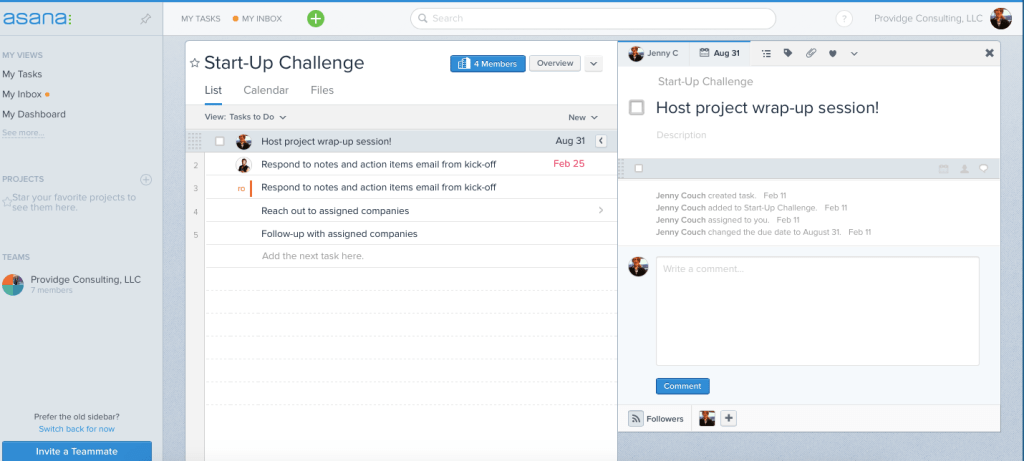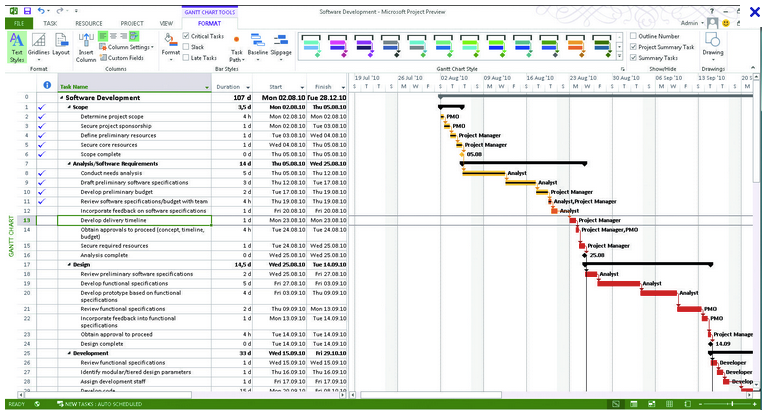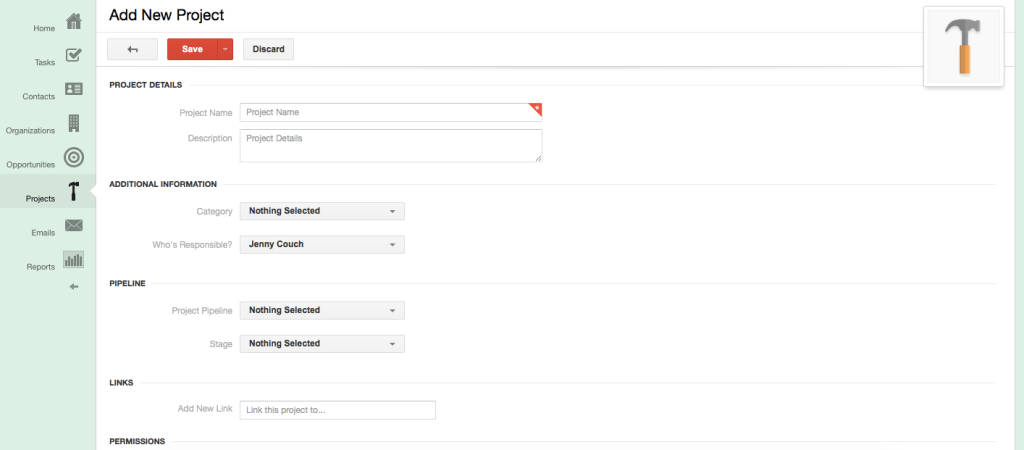You’ve just been assigned as the lead for a new project. It’s a great opportunity for your career. You finally have a chance to demonstrate your ability to manage a team. But first, you have to figure out how you’re going to, well, manage a team and their tasks.
But fear not, there are a wide range of project management platforms that make managing your team and tasks easier for any project.
The list below is just a handful of the platforms available. I selected the five below for a few reasons: I have personally used them to manage a project; they represent the wide range of options available on the market; and all 5 – Asana, Basecamp, Microsoft Project, Evernote, Insightly – improve project transparency and collaboration. Make sure to research your options as one of these other platforms might be a better fit for you.
ASANA
Best For: Teams that want a straight forward way to track project tasks, and monitor progress. You’re the type of person that doesn’t want all the fancy ‘bells and whistles.’ You want to know what’s due when, and who is involved. You also likely love making to-do lists as the interface feels akin to an old-school, paper-based to-do list.
Key Features: I personally enjoy Asana’s interface, and focus on a few core features. It prevents you from feeling overwhelmed. Or, like your platform isn’t helping you to do the one thing you want it to do – manage a project – because it’s too complicated to use. It does take a little time to get used to some of the options – like commenting on tasks, etc. but once you have the hang of it, it’s easy to use. The activity feed bears a similarity to Facebook (unsurprising as it was created by a Facebook co-founder), which makes it easy to start using. Project permissions are also a great feature, allowing you to limit who has access to each project.
Pricing: Free for the basic package. If you want to upgrade to premium, prices start at $21 per month for 5 users, up $750 per month for 100 users.
Integrations: Dropbox, HipChat, Slack, Harvest, WordPress, GitHub, GoogleDrive
BASECAMP
Best For: Are you looking for a simple, aesthetically pleasing tool, that still offers a solid range of features without overwhelming you? Then Basecamp is a great choice. It’s important to note though that Basecamp, while providing some excellent features, doesn’t provide everything you might need to effectively manage your project. A wide-range of separate services exist that integrate with Basecamp, but it will get expensive quickly.
Key Features: Although we didn’t have to use, the support from Basecamp is supposed to be excellent. You can easily customize your project view (list, snapshot, snapshot w/summary); and you have the ability to display projects in all sorts of formats: calendar view, open tasks, project progress. It’s also easy to view everything currently assigned to you in one place – just click the “Me” button in the header. The view “Everything” option is helpful too, as you can view things like “Browse Every Discussion” or “Read All Text Documents” with one click.
Pricing: 60 days of unlimited use for free. Prices range from $20 per month for 10 active projects, with 3GB, and unlimited users, to their Unlimited package which costs $3,000 per year.
Integrations: Harvest, Cyfe, cloudHQ, LucidMeetings, and many others.
MICROSOFT PROJECT
Best For: Projects with strict timelines, loads of dependencies and buckets of cross functional interaction. You should also have experience using Microsoft Project previously. It’s a wonderfully robust tool, that can do amazing things, but it’s very easy to start abusing the tool’s features if you don’t have experience using the platform.
Key Features: Where to even start? The Gantt charts, which visualizes your project timeline, can help you determine at what points your team members are over-extended. The ability to create dashboards on project progress is extraordinarily helpful if you will frequently be presenting to project status updates to leadership or executive teams. The templates Microsoft Project offers may decrease the time you might otherwise spend building out the structure of your project.
Pricing: The pricing for Microsoft Project varies wildly depending on how you want to access it and how robust you want the features to be. It ranges from $7 per user per month, to a one-time $1,159 bill.
Integrations: Skype and Sharepoint depending on the package you select.
EVERNOTE:
Best For: Projects without hard deadlines, and lots of dependencies. It’s a great platform for creative-driven projects where you might be constantly snapping photos of concepts or potential ideas to review later. It’s also a great platform if you frequently need to brain-dump as it’s search capabilities are marvelously powerful (search by tags, notes, notebooks, keywords, etc.). But if you need to stick to hard deadlines, and have a rigid task process, Evernote is not going to cut it.
Key Features: Evernote doesn’t immediately come to mind when considering potential project management platforms, but that’s only because we’ve underestimated just how powerful Evernote can be for the right type of project. You can share notebooks with your teammates, use Evernote’s chat feature, set reminders, and tag your notes to make searching easy. If you’re constantly on the go make sure to take advantage of Evernote’s new auto-capture feature for all sorts of documents (whiteboards, post-it notes, pages, etc.), and its voice capabilities. And they recently launched their new web clipper tool, allowing you to easily save anything you find interesting on the web.
(source Mac Update)
Pricing: Free for the basic package. The Premium package is $49.99 a year, but features a number of worthwhile features such as offline access, the ability to annotate PDF attachments, and unlimited uploads.
Integrations: So. Many. Options. RedBooth and SmartSheet (two other project management platforms not covered in this post). Expensify (save and manage your expense reports – amazing!), CollabSpot, EasilyDo, Pocket and so many others.
INSIGHTLY
Best For: Smaller teams and projects with a limited number of dependencies. Also, fans of Google Apps. Insightly plays well with the entire Google Suite. You will likely need to invest some time up front in customizing Insightly to suit your project needs – I wouldn’t recommend using this platform, unless you plan to also use the CRM platform (see the note on pricing), so this platform may be best suited to marketing or sales teams.
Key Features: The ability to customize the project form with your own fields to meet your needs. Similarly, you can create project pipelines and stages which is useful for projects that have similar steps. The linking feature is another helpful component, allowing you to link any project to a contact, company, or opportunity.
Pricing: You can’t access the Project function as a stand-alone, as it’s part of Insightly’s larger CRM platform. That said, the pricing for the entire platform is very reasonable. Insightly offers multiple packages, from the Basic package which is free, to an Enterprise level offering running $99 per user, per month.
Integrations: MailChimp, Quickbooks, Google Apps, Dropbox, Box, EverNote and many others.
Written By:
[us_person name=”Jenny Couch” role=”Business Development Manager” facebook=”” twitter=”@jenkcouch” linkedin=”https://www.linkedin.com/in/jennycouchrolon” email=”jennycouch@providge.com” link=”” image=”https://providge.com//srv/htdocs/wp-content/uploads/2015/06/jenny_couch.jpg”] Jenny is a project management consultant, and Providge’s Business Development Manager. She loves efficiency, to-do lists, and delivering projects on-time and on-budget [/us_person]




